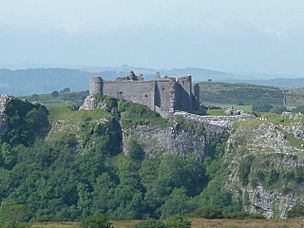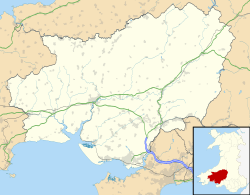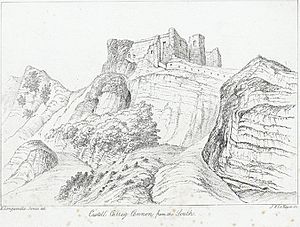Carreg Cennen Castle facts for kids
Quick facts for kids Carreg Cennen Castle |
|
|---|---|
| Carmarthenshire, Wales | |

The south wall and cliff face of Carreg Cennen Castle
|
|
| Coordinates | 51°51′17″N 3°56′06″W / 51.8546°N 3.9349°W |
| Grid reference | Postcode: SA19 6UA |
| Site information | |
| Condition | Ruined |
| Site history | |
| Materials | local Carboniferous Limestone |
| Battles/wars | Surrendered to Owain Glyndŵr following a siege. |
| Events | Demolition by Yorkists in Wars of the Roses |
|
Listed Building – Grade I
|
|
Carreg Cennen Castle (which means castle on the rock above the Cennen in Welsh) is an old castle in Wales. It is found near the River Cennen, close to the village of Trap. This is about four miles south of Llandeilo in Carmarthenshire.
The castle is inside the Brecon Beacons National Park. Its spot is amazing because it sits high up on a limestone cliff. Carreg Cennen has been a ruin since 1462. Today, Cadw, the Welsh Government's history service, looks after it.
Contents
Exploring Carreg Cennen Castle
Carreg Cennen Castle has strong walls and towers. It is built around a square courtyard. There are six towers, all with different shapes. The main entrance is a large gatehouse with two towers on the north side.
Inside the castle, on the east side, you would find rooms like a hall, kitchens, and a chapel. There was also a special room called the 'King's Chamber'. This room had a fancy stone fireplace and beautiful windows. One window looked into the courtyard, and another offered great views to the south. These parts were built in the late 1200s or early 1300s.
The castle was well protected. To the south, there are steep limestone cliffs. To the west, there are ditches cut into the rock. On the north and east sides, there was an outer area and a barbican (a fortified gate). Three drawbridges over deep pits guarded the way into the main castle area.
A cool secret of the castle is a natural cave. In the south-east corner, steps lead down to a vaulted passage and into this cave. It goes deep into the hillside. A fresh spring flows in the cave. This was very helpful for getting water, especially when it was dry.
Today, Cadw helps keep the castle safe and has fixed some parts. You can visit the castle by walking up a steep path from Castell Farm. The farm has a shop and tearooms in an old barn.
The castle did not have a separate 'keep' (a main tower). Instead, the gatehouse was the tallest part and acted as the castle's main strong point.
How the Castle's Rock Was Formed
The castle sits on a special rock formation. It's part of something called the Carreg Cennen Disturbance. This is a very old area of faults (cracks in the Earth's crust) and folds in the rocks. It stretches from Pembrokeshire to Shropshire.
The castle is on a piece of Carboniferous Limestone. This rock is trapped between two faults. The land around the castle is made of a different rock called Old Red Sandstone. This geological disturbance also shaped the nearby Afon Cennen river. During the Ice Age, glaciers, and later the river, found it easier to cut through these weaker rocks.
Early Days of the Castle
People have lived in this area for a very long time. Human remains found here show activity from prehistoric times. The site might have even been an Iron Age hillfort.
Roman coins from the 1st and 2nd centuries have also been found. However, it's unlikely the Romans lived here all the time.
The first stone castle was probably built by Lord Rhys, a Welsh ruler, who died in 1197. The castle stayed with his family for about 50 years. In 1248, Rhys Fychan ap Rhys Mechyll's mother, Matilda de Braose, gave the castle to the English. But Rhys took it back before they could claim it.
For the next 30 years, the castle was often fought over. Rhys and his uncle Maredudd kept taking it from each other. They were fighting for control of the Welsh kingdom of Deheubarth. In 1277, the English captured it. The Welsh took it back in 1282, but the English had it again the next year.
In 1283, King Edward I gave the castle to John Giffard. Giffard was an English commander. He probably helped rebuild the castle into what we see today.
Owain Glyndŵr's Attack
In July 1403, Owain Glyndŵr, a Welsh leader, attacked Carreg Cennen. He had 800 men with him. They caused a lot of damage to the walls. But they could not capture the castle.
The castle was defended against Glyndŵr's forces for several months. Owain himself was there during the siege. The person defending it was Sir John Scudamore. He would later marry one of Glyndŵr's daughters.
The Wars of the Roses
The damage from Glyndŵr's attack was fixed by 1409. However, in 1461, during the Wars of the Roses, Carreg Cennen became a stronghold for the Lancastrian side.
Later, a Yorkist army captured the castle. They decided to destroy it. A team of 500 men worked to pull parts of the castle down.
Recent Times
Over time, the castle was owned by the Vaughan and Cawdor families. From the 1700s, artists like J. M. W. Turner started drawing the castle.
In the 1800s, the second Earl Cawdor began fixing up the castle. In 1932, Carreg Cennen was given to the care of the Office of Works. In the 1960s, the Morris family of Castell Farm bought the castle. This happened because of a mistake in the legal papers!
Today, the castle is still privately owned by Margaret and Bernard Llewellyn. Cadw helps maintain it. You can visit the castle every day.
Images for kids





